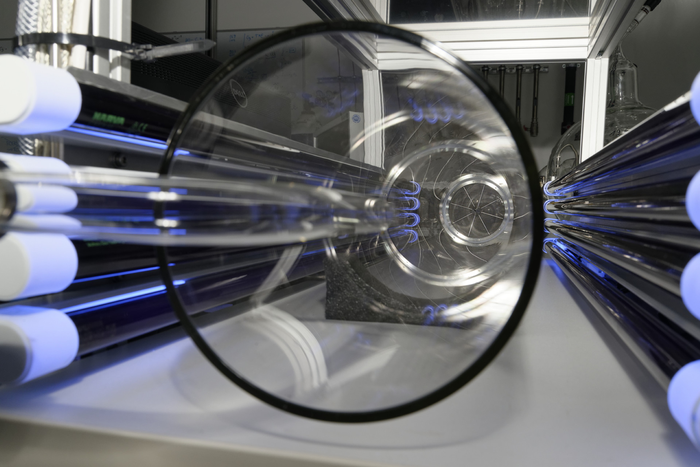Leipzig/Copenhagen/Pasadena. An international research team has now succeeded in detecting hydrotrioxides (ROOOH) for the first time under atmospheric conditions. Until now, there was only speculation that these organic compounds with the unusual OOOH group exist. In laboratory experiments, their formation during the oxidation of important hydrocarbons, such as isoprene and alpha-pinene, have been clearly demonstrated. By means of quantum chemical calculations and model calculations, important data on this new class of substances have been estimated. About 10 million metric tonnes per year of them are formed in the Earth’s atmosphere through isoprene oxidation. The lifetime of ROOOHs is estimated to be minutes to hours. Hydrotrioxides represent a hitherto unnoticed class of substances in the atmosphere, the effects of which on health and the environment need to be investigated, write the researchers led by the Leibniz Institute for Tropospheric Research (TROPOS) in the current issue of the renowned scientific journal SCIENCE.

Credit: Tilo Arnhold, TROPOS
Leipzig/Copenhagen/Pasadena. An international research team has now succeeded in detecting hydrotrioxides (ROOOH) for the first time under atmospheric conditions. Until now, there was only speculation that these organic compounds with the unusual OOOH group exist. In laboratory experiments, their formation during the oxidation of important hydrocarbons, such as isoprene and alpha-pinene, have been clearly demonstrated. By means of quantum chemical calculations and model calculations, important data on this new class of substances have been estimated. About 10 million metric tonnes per year of them are formed in the Earth’s atmosphere through isoprene oxidation. The lifetime of ROOOHs is estimated to be minutes to hours. Hydrotrioxides represent a hitherto unnoticed class of substances in the atmosphere, the effects of which on health and the environment need to be investigated, write the researchers led by the Leibniz Institute for Tropospheric Research (TROPOS) in the current issue of the renowned scientific journal SCIENCE.
The lower layer of our earth’s atmosphere is a large chemical reactor in which several 100 million metric tonnes of hydrocarbons are converted each year, which ultimately leads to the formation of carbon dioxide and water. These hydrocarbons are emitted by forests or anthropogenic sources. A wide variety of oxidation processes occur, only some of which are well understood. One recent focus of atmospheric research is on hydrotrioxides (ROOOH). These are gaseous substances with a group consisting of three consecutive oxygen atoms “O” and a hydrogen atom “H”, which is bonded to an organic rest (R). Hydroperoxides (ROOH) with two oxygen atoms have long been known and proven. In the literature, it has previously been speculated that there could be substances in the atmosphere carrying not only two oxygen atoms (ROOH) but also three oxygen atoms (ROOOH). In organic synthesis, hydrotrioxides are used to form special oxidation products in the reaction with alkenes. However, these reactive and thermally unstable hydrotrioxides are produced there in organic solvents at very low temperatures around -80°C and further react. Whether this substance class also exists as a gas in the atmosphere at significantly higher temperatures was unknown until now.
In their study, researchers from the Leibniz Institute for Tropospheric Research (TROPOS), the University of Copenhagen and the California Institute of Technology (Caltech) have now been able to provide direct evidence for the first time that the formation of hydrotrioxides also takes place under atmospheric conditions from the reaction of peroxy radicals (RO2) with hydroxyl radicals (OH). The laboratory investigations were mainly performed at TROPOS in Leipzig in a free-jet flow tube at room temperature and a pressure of 1 bar air – combined with the use of very sensitive mass spectrometers. Additional experimental information, especially on the stability of the hydrotrioxides, was provided by the investigations at Caltech. Quantum chemical calculations were performed by the University of Copenhagen to describe the reaction mechanisms as well as the temperature- and photostability of hydrotrioxides. Global simulations from TROPOS with the chemistry-climate model ECHAM-HAMMOZ enabled an initial assessment of the effects on the Earth’s atmosphere.
“It is really exciting to show the existence of a universal new class of compounds formed from atmospherically prevalent precursors (RO2 and OH radicals),” reports Prof. Henrik G. Kjærgaard from the University of Copenhagen. “It is very surprising that these interesting molecules are so stable with such a high oxygen content. Further research is needed to determine the role of hydrotrioxides for health and the environment,” emphasises Dr. Torsten Berndt from TROPOS. “Our study has shown that direct observation of hydrotrioxides using mass spectrometry is feasible. This means that it is now possible to further investigate these compounds in different systems including, perhaps, the quantification of their abundance in the environment.” explains Prof. Paul O. Wennberg from Caltech.
The significance of the first successful detection of this new substance class “hydrotrioxides” will only become clear in the next few years. However, with the experimental proof and the current knowledge, the research study by Berndt et al. has laid first groundwork that should also awake the interest of other research groups. Tilo Arnhold
Journal
Science
DOI
10.1126/science.abn6012
Method of Research
Experimental study
Subject of Research
Not applicable
Article Title
Hydrotrioxide (ROOOH) formation in the atmosphere
Article Publication Date
27-May-2022
COI Statement
The authors declare that they have no competing
interests.




